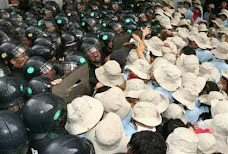

This year, World Water Day coincides with the International Year of Sanitation, challenging us to spur action on a crisis affecting more than one out of three people on the planet.
Every 20 seconds, a child dies as a result of the abysmal sanitation conditions endured by some 2.6 billion people globally. That adds up to an unconscionable 1.5 million young lives cut short by a cause we know well how to prevent.
Poor sanitation combines with a lack of safe drinking water and inadequate hygiene to contribute to the terrible global death toll. Those who survive face diminished chances of living a healthy and productive existence. Children, especially girls, are forced to stay out of school, while hygiene-related diseases keep adults from engaging in productive work.
Leaders who adopted the Millennium Development Goals in 2000 envisioned halving the proportion of people living without access to basic sanitation by the year 2015 -- but we are nowhere near on pace to achieve that Goal. Experts predict that, by 2015, 2.1 billion people will still lack basic sanitation. At the present rate, sub-Saharan Africa will not reach the target until 2076.
Sanitation is vital for health
Sanitation contributed to social development
Sanitation helps the environment
Why improved sanitation is important for children
Sanitation is achievable
Sanitation by numbers
10 Things you should know about sanitation (WHO/UNICEF/WSSCC)
Naciones Unidas ha presentado oficialmente el Día Internacional de Saneamiento para acelerar el progreso de 2.6 billones de personas en el mundo que no tienen servicios de saneamiento adecuados.
El del Día Internacional del Saneamiento ha sido organizado por el departamento de Asuntos Económicos y Sociales (UNDESA por sus siglas en inglés) en colaboración con la Fuerza de Trabajo de Naciones sobre el Saneamiento del Agua.
Cerca del 41% de la población mundial, es decir, 2mil 600 millones de personas, de ellas 980 millones son menores de edad, NO tienen acceso a instalaciones de agua y saneamiento básicas.
Por eso 2008 es el Año Internacional del Saneamiento, es decir, poner una meta, y conscientizar a la población de que casi la mitad del mundo no tiene acceso a agua en condiciones salubres.
1.5 millones de niños mueren por la falta de agua salubre (diarrea, malaria y otras enfermedades)

África es el continente con peores condiciones de saneamiento.
Entre 1990 y 2004 aumentaron las cifras de personas sin acceso a agua potable, pasando de 124 millones a 157 millones.

En África Subsahariana la posibilidad de morir de diarrea de un bebé es 520 veces mayor a la de uno nacido en Europa o en los Estados Unidos.
En América Latina y El Caribe, para 2004 se contabilozaron 125 millones de personas sin acceso a algún sistema adecuado de saneamiento, de ellas 14% en áreas urbanas y 51% rurales.
De las áreas rurales, 92 millones no tienen acceso a agua segura y 128 millones no tienen servicios de alcantarillado adecuados.
En las áreas urbanas, 39 millones no tienen acceso a agua segura y 54 millones no tienen servicios de alcantarillado adecuados.
Brasil, Argentina y Venezuela son los países de la región que más invierten en saneamiento.
En Uruguay el 100% usa saneamiento mejorado.

Más información/More info aquí, aquí































No hay comentarios:
Publicar un comentario